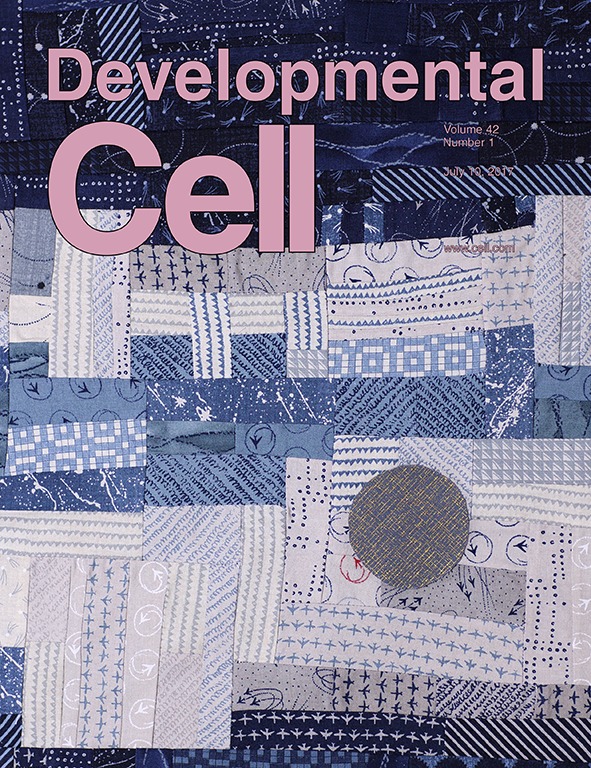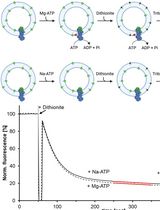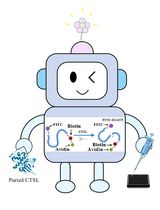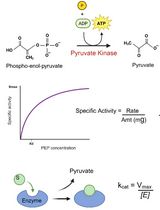- EN - English
- CN - 中文
Guanine Nucleotide Exchange Assay Using Fluorescent MANT-GDP
使用荧光MANT-GDP的鸟嘌呤核苷酸交换测定法
发布: 2018年04月05日第8卷第7期 DOI: 10.21769/BioProtoc.2795 浏览次数: 14669
评审: Ralph Thomas BoettcherAkira KarasawaSarah Diermeier
Abstract
GTPases are molecular switches that cycle between the inactive GDP-bound state and the active GTP-bound state. GTPases exchange nucleotides either by its intrinsic nucleotide exchange or by interaction with guanine nucleotide exchange factors (GEFs). Monitoring the nucleotide exchange in vitro, together with reconstitution of direct interactions with regulatory proteins, provides key insights into how a GTPase is activated. In this protocol, we describe core methods to monitor nucleotide exchange using fluorescent N-Methylanthraniloyl (MANT)-guanine nucleotide.
Keywords: GTPase (GTP酶)Background
GTPases are guanine nucleotide binding proteins that regulate a breadth of cellular processes, ranging from protein biosynthesis to cell-cycle progression and from cytoskeletal reorganization to membrane trafficking. GTPases can be thought of as molecular switches that cycle between a GDP-bound ‘off’ state and a GTP-bound ‘on’ state; upon GTP-binding via nucleotide exchange of GDP for GTP, GTPases become active and will bind to down-stream effector proteins to recruit and activate the biological function of these effectors. GTPases bind the γ-phosphate of GTP via interactions with a highly conserved threonine of the switch I loop (G2 domain) and a glycine within a DxxG motif of the switch II loop (G3 domain). Upon GTP hydrolysis, the loss of the interaction with the γ-phosphate causes a dynamic conformational change that turns the GTPase into an off state (Vetter and Wittinghofer, 2001). Typically, small GTPases have a very high affinity for guanine nucleotides, with dissociation constants in the nanomolar to picomolar range (Bos et al., 2007), and therefore require guanine nucleotide exchange factors (GEFs) to lower their nucleotide affinity to allow for rapid activation. Notable exceptions include several highly conserved centrosomal/ciliary small GTPases, such as Rabl2 (Kanie et al., 2017), ARL13B (Ivanova et al., 2017), Ift27/Rabl4 (Bhogaraju et al., 2011), and Arl6 (Price et al., 2012), and many large GTPases, such as the dynamin family (Gasper et al., 2009), which have lower affinities for GDP/GTP, with dissociation constants in the micromolar range. In this configuration, these GTPases can become activated without the use of GEFs via their intrinsic nucleotide exchange. Although small GTPases that show spontaneous exchange may have additional regulatory proteins, finding that a small GTPase has a micromolar affinity for GDP/GTP and is capable of spontaneous exchange may suggest the absence of a traditional GEF and suggest looking for other forms of GTPase regulatory factors (see Kanie et al. [2017] for a notable example).
Fluorescently-labeled guanine nucleotides are more suitable for monitoring nucleotide exchange than radioactive GDP/GTP, as they are safer and allow continuous spectroscopic monitoring and thus provide a more detailed analysis of kinetics. N-Methylanthraniloyl (MANT) is the most widely used fluorescent analog to label guanine nucleotides because it is smaller than most fluorophores and unlikely to cause major perturbations of protein-nucleotide interactions (Hiratsuka, 1983). Another attractive feature of this fluorescent nucleotide is that the emitted fluorescent signal increases dramatically upon binding to a GTPase (typically twice as high as the signal of unbound MANT-guanine nucleotide) (John et al., 1990), allowing one to directly monitor the association and dissociation of guanine nucleotides from GTPases. The most commonly used method to monitor nucleotide exchange is tracking the decrease in the fluorescence of protein-bound MANT-GDP upon addition of an excess amount of GppNHp, a non-hydrolyzable GTP analog. MANT-GDP-bound GTPase can be prepared by the incubation of nucleotide free GTPase with 1.5 fold excess of MANT-GDP (John et al., 1990; Eberth and Ahmadian, 2009). Although this protocol is described in great detail and allows us to save expensive MANT-GDP, it is time-consuming and limited by the accessibility to high performance liquid chromatography. Alternatively, we describe here a simpler protocol where MANT-GDP is loaded onto GTPase by incubating GTPase with 20-fold molar excess of MANT-GDP in the presence of ethylenediaminetetraacetic acid (EDTA). EDTA chelates magnesium ions, which form coordination bonds with the β and γ phosphates of GTP (or β phosphate of GDP) and with the GTPase (Pai et al., 1990; Tong et al., 1991). EDTA significantly lowers the affinity of the GTPase for guanine nucleotide. The loading reaction is stopped by the addition of excess magnesium chloride. Unbound MANT-GDP is removed by gel filtration using a NAP-5 prepacked column and the nucleotide exchange reaction is initiated by the addition of 100-fold molar excess of GppNHp. Exchange is monitored by a decrease in the fluorescent signal as recorded by a spectrometer with excitation wavelength at 360 nm and emission at 440 nm.
Variations on this method are readily accomplished by addition of biochemically pure nucleotide variants, drugs, or purified protein regulatory factors, allowing for a range of mechanistic experiments and definitive tests of biochemical mechanisms.
Materials and Reagents
- Microcentrifuge tube (Corning, Costar®, catalog number: 3621 )
- 50 ml conical tube (Thermo Fisher Scientific, Thermo ScientificTM, catalog number: 339652 )
- Oak ridge tube (Thermo Fisher Scientific, Thermo ScientificTM, catalog number: 3119-0050 )
- 15 ml conical tube (Thermo Fisher Scientific, Thermo ScientificTM, catalog number: 339650 )
- (Optional) Amicon ultra concentrator (Merck, catalog number: UFC901024 )
- Dialysis tubing (Thermo Fisher Scientific, Thermo ScientificTM, catalog number: 88242 )
- NAP-5 columns (GE Healthcare, catalog number: 17085301 )
- Aluminum foil
- 384-well microplate (Greiner Bio One International, catalog number: 784076 )
- (Optional) 96-well microplate (Corning, catalog number: 3686 )
- 0.2 µm disposable bottle top filter (Thermo Fisher Scientific, Thermo ScientificTM, catalog number: 597-4520 )
- 0.22 µm syringe filter (Merck, catalog number: SLGV033RS )
- Disposable cuvettes (Fisher Scientific, catalog number: 14-955-127 )
- Multichannel pipette tip (Thermo Fisher Scientific, Thermo ScientificTM, catalog number: 7421 )
- Rosetta2 bacterial cells (Merck, EMD Millipore, catalog number: 71403 )–Store at -80 °C
- Recombinant GTPase
Note: Ideally, the concentration should be 100 µM or greater. See the protocol below for the expression and purification of recombinant GTPases. Store at -80 °C. - Gateway-cloning compatible pGEX6p vector
- 4x LDS sample buffer (Thermo Fisher Scientific, InvitrogenTM, catalog number: NP0008 )
- 2-Mercaptoethanol (Sigma-Aldrich, catalog number: M3148 )–Store at 4 °C
- GppNHp (Abcam, catalog number: ab146659 )
Note: Dissolve in Milli-Q water to prepare a 50 mM stock solution. Store at -20 °C. - Nu-PAGE gel (Thermo Fisher Scientific, InvitrogenTM, catalog number: NP0321BOX )
- Coomassie Brilliant Blue R-250 (Thermo Fisher Scientific, Thermo ScientificTM, catalog number: 20278 )
- (Optional) Classical Laemmli sodium dodecyl sulfate (SDS) sample buffer/SDS-polyacrylamide gel electrophoresis (SDS-PAGE) gel
- Glutathione Sepharose 4B media (GE Healthcare, catalog number: 17075605 )–Store at 4 °C
- GST-PreScission (10 mg/ml)
Note: We prepare GST tagged PreScission by ourselves. 1 µl of our protease cleaves approximately 1 mg of GST-ARL3, a test protein. Alternatively, you can purchase the protease from GE Healthcare, catalog number: 27084301 . Store at -80 °C. - Bradford Reagent Concentrate (Bio-Rad Laboratories, catalog number: 5000006 )–Store at 4 °C
- Liquid nitrogen
- BSA standard, 2 mg/ml (Thermo Fisher Scientific, catalog number: 23209 )–Store at 4 °C
- TritonX-100 (Acros Organics, catalog number: 215682500 )
- Milli-Q water
- Protease inhibitor tablet (Thermo Fisher Scientific, Thermo ScientificTM, catalog number: A32965 )–Store at 4 °C
- Glycerol (Sigma-Aldrich, catalog number: G5516 )
- MANT-GDP triethylammonium salt solution (Sigma-Aldrich, catalog number: 69244 )–Store at -20 °C protected from light
- Trizma base (Sigma-Aldrich, catalog number: T6066 )
- Concentrated HCl (Aqua Solutions, catalog number: H2505-500ML )
- Glacial acetic acid (Fisher Scientific, catalog number: A490-212 )
- Methanol (Fisher Scientific, catalog number: A412-4 )
- HEPES (Sigma-Aldrich, catalog number: H3375 )
- Sodium hydroxide (Fisher Scientific, catalog number: BP359-500 )
- Sodium chloride (NaCl) (Sigma-Aldrich, catalog number: S3014-500G )
- Magnesium chloride hexahydrate (MgCl2·6H2O) (Sigma-Aldrich, catalog number: M2670 )
- Dithiothreitol (DTT) (Promega, catalog number: V3155 )
- Ethylenediaminetetraacetic acid (EDTA) (Fisher Scientific, catalog number: S311 )
- LB broth (Fisher Scientific, catalog number: BP9723 )
- LB agar (Thermo Fisher Scientific, InvitrogenTM, catalog number: 22700 )
- Terrific broth (Fisher Scientific, catalog number: BP24682 )
- Carbenicillin (Sigma-Aldrich, catalog number: C3416 )
- Ampicillin (Fisher Scientific, catalog number: BP1760 )
- Chloramphenicol (Sigma-Aldrich, catalog number: C0378 )
- IPTG (Thermo Fisher Scientific, InvitrogenTM, catalog number: 15529019 )–Store at -20 °C
- LB media (see Recipes)
- TB media (see Recipes)
- 100 mg/ml ampicillin (see Recipes)
- 50 mg/ml carbenicillin (see Recipes)
- 34 mg/ml chloramphenicol (see Recipes)
- LB agar plate containing 50 µg/ml carbenicillin and 34 µg/ml chloramphenicol (see Recipes)
- 1 M IPTG (see Recipes)
- 1 M Tris-HCl (pH 7.5) (see Recipes)
- 1 M HEPES-NaOH (pH 7.5) (see Recipes)
- 5 M NaCl (see Recipes)
- 1 M MgCl2 (see Recipes)
- 1 M DTT (see Recipes)
- 0.25 M EDTA (pH 8) (see Recipes)
- 10 M NaOH (see Recipes)
- Coomassie Brilliant Blue staining solution (see Recipes)
- Coomassie Brilliant Blue destaining solution (see Recipes)
- Lysis buffer (see Recipes)
- PreScission cleavage buffer (see Recipes)
- Storage buffer (see Recipes)
- Low magnesium buffer (see Recipes)
- 2x MANT-GDP loading buffer (see Recipes)
- Nucleotide exchange buffer (see Recipes)
Note: Unless otherwise noted, materials are stored at room temperature. Frozen proteins and nucleotides can be maintained for at least a year if pure.
Equipment
- Milli-Q generator (Merck, model: Milli-Q® Advantage A10, catalog number: Z00Q0V0WW )
- 250 ml culture flask (Corning, PYREX®, catalog number: 4980-250 )
- 2,800 ml culture flask (Corning, PYREX®, catalog number: 4424-2XL )
- Incubator shaker (Eppendorf, New BrunswickTM, model: Excella® E25 , catalog number: M1353-0002)
- Refrigerated centrifuge (Eppendorf, model: 5424 R )
- 500 ml centrifuge bottle (Thermo Fisher Scientific, Thermo ScientificTM, catalog number: 3141-0500 )
- JA-10 rotor (Beckman Coulter, model: JA-10 , catalog number: 369687)
- Avanti J-25I refrigerated centrifuge (Beckman Coulter, model: Avanti J-25I , catalog number: 363106)
- JA-17 rotor (Beckman Coulter, model: JA-17 , catalog number: 369691)
- Allegra X-15R refrigerated centrifuge (Beckman Coulter, model: Allegra® X-15R , catalog number: 392932)
- BioSpectrometer (Eppendorf, catalog number: 6136000010 )
- Thermomixer (Fisher Scientific, catalog number: 05-412-401 )
Note: This equipment has been discontinued. Thermomixer C (Fisher Scientific, catalog number: 05-412-503; Manufacturer: Eppendorf, catalog number: 5382000023 ) is available as an alternative. Any type of temperature-controlled mixer with cooling function should work for this experiment. - TECAN Infinite M1000 Microplate reader (TECAN, part number: 30034301 )
Note: There are a number of plates or cuvette-based fluorimeters that can be adapted to this procedure. Those include FluoroMax-4 (Horiba) (Price et al., 2012), Synergy H4 Hybrid Microplate reader (Bio Tek) (Ivanova et al., 2017), and Envision (Perkin-Elmer) (Maurer et al., 2012). - Branson Digital Sonifier (Branson)
Note: This equipment has been discontinued. Branson Ultrasonics Sonifier SFX250/SFX550 (Fisher Scientific, catalog number: 15-345-141; Manufacturer: EMERSON, Branson, catalog number: 101063969R ) is available as an alternative. - 360° vertical rotator (Grant Instruments, model: PTR-30 )
Note: This equipment has been discontinued. Grant bio 360° vertical rotator PTR-35 (Grant Instruments, model: PTR-35 ) is available as an alternative. - Lab stand (Humboldt, catalog number: H-21207 )
- Vortex mixer (Scientific Industries, model: Vortex-Genie 2 , catalog number: SI-0236)
- Multichannel electronic pipette (Thermo Fisher Scientific, Thermo ScientificTM, catalog number: 2069MTRX )
Note: This equipment has been discontinued. A newer model (Thermo Fisher Scientific, Thermo ScientificTM, catalog number: 4671020BT ) is available as an alternative. - Autoclave
Software
- Microsoft Excel (Microsoft)
- GraphPad Prism 7 software (GraphPad Software)
Procedure
文章信息
版权信息
© 2018 The Authors; exclusive licensee Bio-protocol LLC.
如何引用
Kanie, T. and Jackson, P. K. (2018). Guanine Nucleotide Exchange Assay Using Fluorescent MANT-GDP. Bio-protocol 8(7): e2795. DOI: 10.21769/BioProtoc.2795.
分类
生物化学 > 蛋白质 > 荧光
生物化学 > 蛋白质 > 活性
您对这篇实验方法有问题吗?
在此处发布您的问题,我们将邀请本文作者来回答。同时,我们会将您的问题发布到Bio-protocol Exchange,以便寻求社区成员的帮助。
Share
Bluesky
X
Copy link












